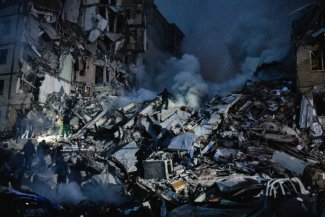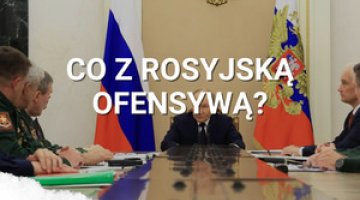Another blow to Ukraine’s energy sector. Day 326 of the war

On 14 January, Russia carried out its twelfth missile attack on the enemy’s energy infrastructure, according to the national power company Ukrenerho. Missiles fell on Kharkiv, Khmelnitsky, Dnipro, Kyiv, Kryvyi Rih, Odesa and Vinnytsia, among other regions. Power facilities were damaged in Kharkiv, Ivano-Frankivsk, Kyiv, Lviv, Vinnytsia, Zaporizhzhia and Odesa oblasts. However, Ukrainian sources have given contradictory reports about the facility in Kyiv which was hit; representatives of Ukrenerho and the energy company DTEK gave no details on the damage or power cuts, but noted that the situation is very difficult, and Ukraine must prepare for hard days or even weeks ahead. The emergency power cuts could last more than 24 hours, and in some regions they could be even longer-lasting. According to the head of YASNO, one of the country’s largest operators, the energy deficit is huge, and numerous heating plants are not working due to serious damage.
One Russian rocket hit a residential block in Dnipro, killing at least 40 people and wounding 75. This was one of the deadliest single attacks on civilian targets since the beginning of the war. In other strikes carried out on 14 January, three civilians were killed and nine wounded. On 16 January, Ukrainian media reported that two people suspected of coordinating an attack on a local (combined) heat and power plant were detained in Dnipro before the attack.
According to the Ukrainian General Staff, the enemy fired a total of 57 missiles on 14 January. It listed 41 cruise missiles and air-launched guided missiles, of which the defenders reportedly destroyed 26. However, the Air Force Command noted that the list of shootdowns only refers to Kh-101/Kh-555 (fired from strategic bombers) and Kalibr cruise missiles (fired from ships; the Russians used half of the 36 missiles of this type which were prepared for firing), as well as Kh-59 TV-guided cruise missiles.
After the attack on Kyiv on the morning of 14 January, when the invaders were expected to attack the city for the first time using S-300 and/or S-400 missiles (most likely from Belarusian territory), the command’s spokesman Colonel Yuri Ihnat said that the Ukrainian air defence did not have the means to shoot down ballistic missiles or those fired from air defence systems (the S-300/S-400s). On the same evening, commenting on the strike on the apartment block in Dnipro, Air Force commander General Mykola Oleshchuk added that Ukrainian troops also have no means of neutralise the Kh-22 cruise missiles used in this attack. On 14 January, the Russians used five such missiles; since the beginning of the war more than 210 of these have been used, none of which have been downed. Only the latest Western air defence systems (including the PAC-3 versions of the Patriot and SAMP/T) are supposed to have this capability. Commenting on his superior’s statement, Colonel Ihnat described previously reported official reports about the shootdowns as erroneous.
Russian artillery and aviation are continuing to shell and bombard Ukrainian army positions and facilities along the line of contact and in border areas, especially in the Sumy oblast. Kherson, Nikopol, Ochakiv and the vicinity of these cities remain the targets of these attacks. On 15 and 16 January, Russian forces also launched further rocket attacks on Kramatorsk, Lyman and Zaporizhzhia. Ukrainian rocket artillery reportedly hit Melitopol, and Sevastopol was the target of a drone attack.
The Ukrainian defence ministry has indirectly admitted that Soledar has been lost: fighting is now expected to take place in the vicinity of the town. Enemy forces are continuing to push westward between the northern outskirts of Bakhmut and Rozdolivka, 10 kilometres south of Siversk. They are trying to push the defenders out of the towns, along the railroad and the road between the two towns, and to the south and east of the latter. The Russians have outflanked Klishchiivka, south of Bakhmut, and are likely to take up positions on the western side of the Donets-Donbas canal. Clashes are continuing in the north-eastern part of the town and on its southern outskirts, as well as west of Horlivka and in a wide arc west of Donetsk (Mariinka is still the site of the heaviest skirmishes here). The invaders have also become active in the western part of the Donetsk oblast, where Ukrainian sabotage and reconnaissance groups are also likely operating. In the Luhansk oblast, fighting is taking place mainly in the Kreminna area, and both sides have attempted assaults there.
On 14 January, London confirmed its intention to hand over a company of Challenger-2 tanks to the Ukrainian army. The 14 vehicles are expected to leave within a few weeks (there should be four machines in the first tranche). The British also announced that it would deliver 30 155-mm AS90 self-propelled howitzers to Kyiv, which should reach Ukraine after the tanks. Media reports that the UK would also send four Apache attack helicopters along with the tanks proved incorrect. The Italian government, on the other hand, has decided to send a battery of the SAMP/T medium-range air defence missile system with limited anti-ballistic capabilities (which can shoot down short-range ballistic missiles). However, it was not stated when this would take place. The management of Rheinmetall has announced that the delivery to Ukraine of the Leopard (88 units) and Leopard-2 (22) tanks which are currently in storage could – if the German government takes that decision – not take place any earlier than 2024.
A day earlier, the Security Service of Ukraine announced that it had conducted exercises in the Rivne oblast on the border with Belarus. The training scenario envisaged the neutralisation of hostile sabotage and reconnaissance groups attempting to break through the border. The participants in the training have comprehensively developed algorithms for interdepartmental cooperation to prevent possible threats of sabotage (against nuclear facilities, among other targets) in the border regions of north-western Ukraine. On 15 January, the head of the Rivne Oblast Military Administration revealed that the border strip with Belarus had been mined. Engineering and fortification structures (such as anti-tank ditches) designed to impede a possible offensive from Belarusian territory are also being expanded.
A two-week joint Russian-Belarusian tactical aviation exercise, included in the air component of the Regional Army Grouping, began in Belarus on 16 January. Its main objective is to increase interoperability in aerial reconnaissance, the joint patrolling of airspace along Belarus’s borders, air support for army groupings, carrying out transport tasks, and evacuating the wounded.
On 13 January, the Ukrainian human rights ombudsman Dmytro Lubinets summarised the results of the third round of negotiations with his Russian counterpart Tatyana Moskalkova. During the meeting in Turkey, the parties discussed an initiative to speed up the return of POWs and the release of imprisoned civilians. The latter were classified into several categories: those detained by Russia between 2014 and 24 February 2022, including in Crimea (the so-called Kremlin prisoners, numbering 158 people); those detained in Donetsk and Luhansk oblasts (373 people), and those detained by Russia in all occupied territories. Lubinets noted that so far his office has been contacted by more than 20,000 families looking for their loved ones.
According to an assessment released to the media on 14 January by the Ukrainian Military Intelligence Service (HUR), Vladimir Putin’s moves to reorganise the economy and the military-industrial complex signal the possibility that martial law may be introduced in Russia. Steps taken by the Kremlin to use as many military resources as possible, together with the appointment of Valery Gerasimov, the Chief of the General Staff of the Russian Armed Forces, as the new commander of the aggression against Ukraine, testify to the Kremlin’s readiness to continue a long-term, large-scale war. Commenting on reports about a conflict between Yevgeny Prigozhin, the owner of the Wagner private military company, and the leaderships of the Defence Ministry and the General Staff, HUR pointed out that measures have been taken in Russia to marginalise the role of Wagner in the war in the media. The Russian defence ministry has drawn up recommendations for Kremlin propagandists on how they should report on events in Ukraine. These include reporting only from sources approved by the ministry, emphasising the leading roles of the defence minister and chief of general staff, justifying attacks on the enemy’s critical energy infrastructure as ‘indispensably necessary’, highlighting the topic of Kyiv’s supply of Western weapons, promoting the thesis that Russia is conducting a ‘military operation’ against all of NATO, and mentioning Wagner only in the negative context of losses suffered during ‘senseless’ attacks. On 15 January, HUR warned that Russian special services would try to use Ukrainian journalists to conduct informational and psychological operations. To this end, the services will contact Ukrainians who are media-active, in the name of Western editorial boards, and offer to provide them with messages about the state of the economy, the political situation and the activities of the armed forces.
Commentary
- This latest missile attack on Ukraine’s energy infrastructure was not one of the largest: it used about half the number of missiles used in the largest strikes last autumn. This confirms that Ukraine’s energy system has already suffered such significant damage that the aggressor needs fewer and fewer resources to keep the country in a state of permanent energy shortage, but also that such attacks can be repeated less and less frequently (two weeks have passed since the previous one, while in the autumn they took place once a week on average).
- The significant change in the policy of the Ukrainian Air Force Command in terms of reporting on missile defence capabilities should not just be seen as a confirmation of the status quo. It represents a dramatic appeal to the Western community to deliver modern medium-range air defence systems as soon as possible, and is also an indirect criticism of the support Ukraine has received to date. The statements by the Command’s representatives show that even the delivery of the relatively modern NASAMS and IRIS-T systems has not brought about a qualitative change, and the defenders are still unable to shoot down missiles of certain categories and types. Moreover, the statements by General Oleshchuk and Colonel Ihnat shatter the existing narrative that Ukraine has so far been relatively effective at countering the enemy missile strikes: they have not only undermined the reports that some categories and types of missile have been shot down (principally Iskander ballistic missiles), but they also cast doubt on the claimed percentage of hits in relation to the number of missiles the Russians have used.
- Russian forces in the Donbas are trying to capitalise on the success they have achieved in the past week, and are continuing their attacks. These are aimed at outflanking Bakhmut and Siversk and, as a consequence, at significantly impeding the defence of these towns, or at least forcing the Ukrainian forces to withdraw from both places and build new lines of defence west of Slovyansk and Kramatorsk. As a result of the problem they have had with stabilising defences in the Bakhmut area, Ukrainian troops are trying to regain the initiative north of Siversk and prevent the loss of this town by resuming attacks in the direction of Kreminna. This will be helped both by the defenders’ reinforcement of the strike grouping on the border of the Donetsk, Luhansk and Kharkiv oblasts, and by the fact that units which conducted the successful offensive in Kharkiv oblasts are now operating there. These units still have offensive potential, and capturing Kreminna has been their main objective since October.




